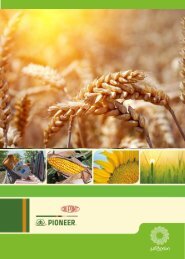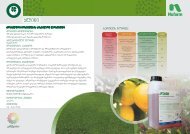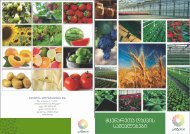You also want an ePaper? Increase the reach of your titles
YUMPU automatically turns print PDFs into web optimized ePapers that Google loves.
General Terms and Conditions of of Sale Sale (Enza Zaden’s ref. ref. no. no. EX08) EX08)<br />
Schedule 1 - Product Specifications<br />
1. - Introduction<br />
Vegetable growing has become a highly specialized and intensive activity. As a result of the ever<br />
increasing demand for a better quality, vegetable growers and plant raisers require an improved quality<br />
of basic material.<br />
The demand for specific seed forms and more information about seed quality has strongly increased to<br />
better influence emergence and required number of plants.<br />
Seed is a natural product. The often varying environmental conditions thus influence final results. It<br />
is therefore often not possible to give detailed information about seed performance and other seed<br />
characteristics.<br />
In order to meet customer’s demands, ECS has drawn up quality standards for the various seed<br />
categories.<br />
The specifications mentioned are ECS’ minimum standards. In relation to germination, the specifications<br />
are based on the use of ISTA methods. In the event that the seed does not meet the product<br />
specifications mentioned, ECS will inform their customers.<br />
2. - General Definitions<br />
a) ‘Normal Seed’<br />
In general normal seed has not been subjected to special processes. It is sold by weight and/or by<br />
count, depending on the product. Normal seed complies with the EEC standards.<br />
b) ‘Precision’<br />
‘Precision’ seed has been subjected to additional processes. It is of a uniform size and has high<br />
germination capacity. ‘Precision’ seed is sold by count and complies with the standards as provided<br />
in the table below.<br />
c) ‘Priming’<br />
Priming is defined as an activation of the germination process in order to break seed dormancy or<br />
obtain a faster or more uniform emergence after sowing. Primed seed is sold by count.<br />
d) ‘Pill’<br />
Pill is the product of a seed pelleting/coating procedure. Pelleting is defined as the process of<br />
changing the seed form by covering it with filling materials with the main purpose to facilitate easier<br />
sowing. Also additional ingredients may be added. Pelleted seed is sold by count and complies with<br />
the standards as provided in the table below.<br />
e) ‘Filmcoat’<br />
Filmcoat is a full covering, usually pigmented layer around the seed. The original seed form remains<br />
intact. Additional ingredients may be added. Filmcoat is used for insecticide treatments by Enza<br />
Zaden. Filmcoated seeds are sold by count.<br />
f) ‘Basiscoat’<br />
Basiscoat is a pigmented layer around the seed. The original seed form and size remain intact.<br />
Basiscoat is mainly used for fungicide treatments by Enza Zaden.<br />
g) ‘Germination’<br />
The germination figure mentioned is valid from the moment of delivery. Germination figures refer to<br />
the ISTA procedures.<br />
h) ‘Genetic Purity’<br />
Genetic Purity is defined as the percentage of plants derived from a seed lot that meets the variety<br />
description.<br />
3 - Information per crop<br />
Crop Product Germination % Seed Size mm Genetic Purity<br />
Crop Product Germination % Seed Size mm Genetic Purity<br />
Cauliflower Precision 90<br />
0.20 or 0.25<br />
round sieve<br />
90<br />
Butterhead, Batavia,<br />
Iceberg, Cos<br />
Precision 93 98<br />
Others Brassica Precision 90 93<br />
Butterhead, Batavia,<br />
Iceberg, Cos<br />
Pill 95 98<br />
Carrot Precision 85<br />
0.20 or 0.25<br />
round sieve<br />
Others Lettuce Precision 93<br />
Celery Pill 90<br />
Others Lettuce Pill 95 95<br />
Chicory Witlof Precision 85<br />
Corn salad Precision 85<br />
0.20 or 0.25<br />
round sieve<br />
0.20 or 0.25<br />
round sieve<br />
Melon Precision 90 98<br />
Parsley Precision 87<br />
Cucumber Precision 92 99<br />
Sweet and hot pepper Precision 90 97<br />
Red beet monogerm Precision 80 0.50<br />
Radicchio Precision 88<br />
Red beet multigerm Precision 90 0.50<br />
Radish Precision 92<br />
0.25<br />
round sieve<br />
Eggplant Precision 90 98<br />
Scorzonera Precision 80<br />
Endive Precision 90<br />
Spinach Precision 85 0.75<br />
Endive Pill 92<br />
Squash Precision 92 97<br />
Fennel Precision 90<br />
0.5 round or 0.2<br />
length sieve<br />
Tomato Precision 92 98<br />
Fennel Pill 90<br />
Onion Precision 90 2.00-2.75<br />
Leek OP Precision 90<br />
0.2 or 0.25<br />
round sieve<br />
Watermelon normal Precision 90 98<br />
Leek F1 Precision 85<br />
Watermelon seedless Precision 85 98<br />
Schedule 2 - Resistance<br />
1. - Terminology and definitions<br />
a) ‘Immunity’ means not subject to attack or infection by a specified pest or pathogen.<br />
b) ‘Resistance’ is the ability of a plant variety to restrict the growth and development of a specified<br />
pest or pathogen and/or the damage they cause when compared to susceptible plant varieties under<br />
similar environmental conditions and pest or pathogen pressure. Resistant varieties may exhibit some<br />
disease symptoms or damage under heavy pest of pathogen pressure.<br />
Two levels of resistance are defined:<br />
I. High resistance (HR): plant varieties that highly restrict the growth and development of the<br />
specified pest or pathogen under normal pest or pathogen pressure when compared to susceptible<br />
varieties. These plant varieties may, however, exhibit some symptoms or damage under heavy pest<br />
or pathogen pressure.<br />
II. Intermediate resistance (IR): plant varieties that restrict the growth and development of the<br />
specified pest or pathogen, but may exhibit a greater range of symptoms or damage compared to<br />
highly resistant varieties. Intermediately resistant plant varieties will still show less severe<br />
symptoms or damage than susceptible plant varieties when grown under similar environmental<br />
conditions and/or pest or pathogen pressure.<br />
c) ‘Susceptibility’ is the inability of a plant variety to restrict the growth and development of a specified<br />
pest or pathogen.<br />
2. - Information per variety<br />
Resistances in varieties of our crops will be coded (see coding list at www.enzazaden.com), unless<br />
indicated otherwise. In case a variety is resistant to more than one pathogen, the individual resistance<br />
codes will be separated by the symbol ‘/ ‘.<br />
If in a resistance code of a certain variety reference is made to certain strains for which the resistance is<br />
claimed this means that no resistance is claimed to other strains of the same pathogen.<br />
If, in a resistance code, no reference is made to strains of the pathogen for which the resistance is<br />
claimed, resistance is claimed only to certain not further specified strains of the pathogen and we hereby<br />
disclaim any guarantee that the variety will not be infected by the said pathogen.<br />
www.enzazaden.com<br />
Enza Zaden | 47














